You are currently browsing the collecting category
So last week, when I was a’typin’ about the weirdo Marvel trading card boom allegedly going on right now, Matthew noted (in reference to X-Force (1991) #1’s involvement:
“You’ve mentioned the ‘Shazam! effect’ before in relation to the 1970s Shazam comic and I think there’s an element of that happening here too. I mean, X-Force #1 came out 30 years ago, that’s the same gap between Fantastic Four #1 and X-Force #1. Plus people who were young when it first came out our (potentially) old enough to have money and nostalgia for that thing they used to have?”
I did sort of refer to the Shazam Effect obliquely in that post in the following passage:
“…While millions of X-Force #1 were printed, that doesn’t necessarily follow that millions are out there in readily available circulation. And the ones that do turn up aren’t necessarily going to be in that minty-mint collectable condition.”
…and if someone out there doesn’t remember what that is…in short, the ’70s Shazam! #1 was ordered in huge quantities, with large amounts going unsold. It remained a cheap back issue for decades, often finding its way into quarter boxes and the like…until one day the market realized that actual nice copies were getting harder to come by. Partially due to age, but almost certainly a lot to do with available stock being dumped into said bargain boxes and basically being mishandled and poorly stored and such. And thusly, high grade Shazam! #1s go for a premium.
Now that’s my theory, built upon decades of observation and just how I know early on at the previous place of employment, we’ve just pour the buckets of Shazam! comics into the blow-out boxes and hoped someone would take them away.
This does apply to X-Force #1 (and other early ’90s blockbuster hit comics) a bit, I think. But first, I believe there were a lot more copies of X-Force #1 and its contemporaries printed than of Shazam! #1.
…And that while X-Force #1, in contrast to, say, the ’90s X-Men #1 and Spider-Man #1, did suffer in general reputation and consideration after the market sobered up a bit later in a decade, I don’t think quite the same percentage of them ended up in the bargain bin dregs to be misused and abused. Not saying no copies ended up there, but I believe it wasn’t enough to create a paucity of near mint copies in general circulation. If anything, like I said in my original post, actually being purchased by consumers who didn’t store their comics properly seems to be, just from my general experience, the more likely culprit in this matter.
There’s also the inverse relationship of product versus outlets to consider. Shazam #1 was released as the direct market was beginning, with more and more comic-specific retail stores opening up and presenting more opportunities for Shazam #1 to be sold. Even if, you know, it was just in quarter boxes. X-Force #1 was published just prior to the direct market’s near fatal contraction, with piles of unsold copies of that comic disappearing along with the stores that ordered too many of them. Assuming former store owners didn’t dump their stock on other surviving shops (or, uh, had them shredded), and also assuming proper and not contemptuous storage, there may be masses of mint-ish X-Force #1s still lurking, hidden, waiting to make their move.
Not saying every copy of those unsold Shazam!s got circulated, and that millions of X-Forces aren’t in circulation. But I do think there are potentially enough of those X-Force #1s out there in what would be considered “collectible” shape that all it really takes is one big warehouse/storage unit find for the supposed scarcity of that comic to dissipate. (If I recall correctly, something similar happened to Wally Wood’s Heroes Inc.) As garages and storage areas open up and get cleaned out by their owners, or progressively more often, surviving family members or third-party purchasers, they’re only going to become more common.
And going back to my original assertion, if there is an apparently scarcity to X-Force #1 at all, it comes from newer stores who weren’t around when it came out, and thus didn’t acquire an enormous backlog of unsold copies to dole out over the decades. Newer stores would have to acquire them in collections…and they do pop up there, time and again.
I hope none of this sounds like I’m trying to argue with commenter Matthew…just taking his response as a launching pad for considering the differences in situations here. Which isn’t to say his idea that “nostalgia + relatively shortness in supply” isn’t a fact. Sure it is. And that increased demand for a once moribund back issue is going to cause the prices to rise. But that Deadpool promo card going for hundreds of dollars…that’s almost certainly the result of folks trying to “force” a collectible, to find something relatively common in a market where genuinely scare items are becoming harder to come by, and declaring something “rare” and “hot.” Just by the natural order of things, I think any really high prices on these things is outside the normal causes of supply and demand.
Anyway, there you are. Over-rambly and self-contradictory, in the Mighty Mike Style, but there you go. If I were to sum up…while some price increases can be expected in even over-printed items like X-Force #1 due to a relative dearth of supply at current outlets, it’s still likely not rare enough to cause such extremely high pricing based on ordinary market forces. But none of that matters if it’s decided this is the new normal and that’s what these items go for now, regardless of abundance.
This is all conjecture and opinion based on what I’ve seen over my nearly 33 years in the industry. I could be (gasp) wrong, but this is my general sense of things. You know where to argue with me!
Thanks to Matthew for his response.
Okay, so apparently this is a thing that’s been happening. X-Force #1 from 1991…you know, the comic that sold, what, five million copies…which could be had for under ten bucks, usually closer to about a buck…is suddenly selling for premium prices.
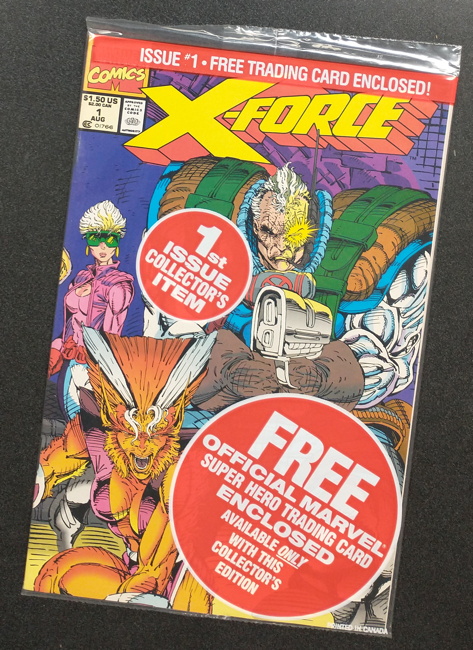
…but specifically the variation that was packaged with a Deadpool trading card (approximately one-fifth of the run, as there were five different cards):
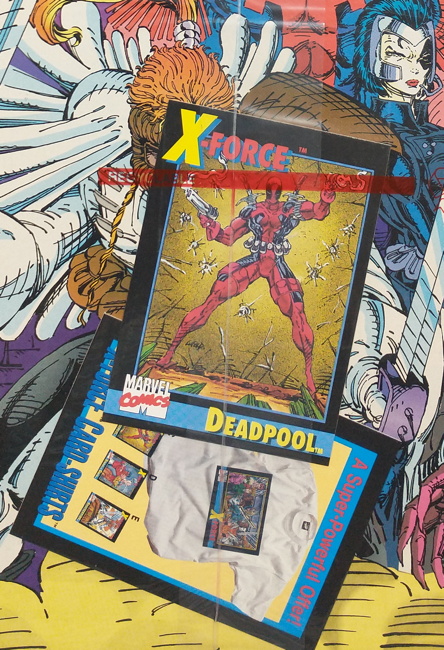
The price that I’ve seen bandied about is “$100” which apparently it did sell for on eBay, but a quick look reveals prices to be more in the $20-$40 range, which is still a lot.
And this is goaded on by the fact that this very Deadpool card, just by itself, is apparently selling for even more premium prices, with this optimistic seller offering up a graded ‘n’ slabbed one for $2600. (“Or best offer,” to be fair.)
It wasn’t that long ago…well, okay, it was 2013 when I talked about how folks didn’t seem to care much about early Deadpool appearances that weren’t New Mutants #98. And then just a couple of years back I noted my surprise at how the Deadpool-carded X-Force #1 was now (well, then) priced in the guide at $18 (which isn’t too far off from where most eBay sales are at the moment). BONUS: you can see that lovely pic of me in the second link wielding a full set of those X-Force #1s, with each card in the set represented.
There are a preponderance of these Deadpool cards listed online as “rookie cards,” which…I don’t know, is kind of weird. I mean, I guess, technically, that card is his second appearance, I think, if you want to refer to tie-in merchandise as “appearances” of characters (which leads to madness like calling an issue of Marvel Age the “first appearance” of Spider-Man’s black suit). But calling it a “rookie” card feels…well, feels like forcing the invention of collectability in a market where genuinely collectible items are becoming harder to come by.
I’ve written before (on Twitter, I think) about how this seems to be driving the current speculator market for current issues, where any first appearance, any deviation from the norm is branded “hot” and because of the very nature of current close-to-the-bone comics ordering by retailers, an already scare item becomes that much more scarce. Who needs to chase after an Amazing Fantasy #15 when you can artificially inflate demand for the first appearance of Gold Lantern, a character everyone’s already forgotten about?
Also tying into things I’ve written about before…while millions of X-Force #1 were printed, that doesn’t necessarily follow that millions are out there in readily available circulation. And the ones that do turn up aren’t necessarily going to be in that minty-mint collectable condition. I assure you, no matter how many bags or boards or Mylars or what was it, “Comic Stor” 3-ring binder sleeves were sold, I am betting, just on personal observation of having been in comics retail for nearly 33 years, that most of the copies that ended up in the hands of consumers at that time have been damaged or destroyed over the decades.
And the large amounts of unsold copies that stores still had after that initial sales window closed back in 1991? Probably vanished along with many of the stores that shut down as soon as that comics boom went bust…probably because they were stuck with too many copies of, oh, say, X-Force #1 and comics like that. So it’s possible a lot of that stock is just sitting in storage units or former retailers’ garages, with no where to go, and no access to potential buyers. Which isn’t to say a comic like X-Force #1 is “rare” by any means…just that you have have a longer search ahead of you finding copies, as not many stores open now were open then to have wholesaled them.
(NOTE: I know I’ve discussed this before, in relation to Valiant’s Turok #1. Longtime readers, I beg your patience as Old Man Mike repeats his stories.)
So anyway, does this have anything to do with X-Force #1 avec une carte à collectionner Deadpool suddenly creeping up in price? It probably doesn’t hurt, but it also appears to be tied to the current secondary market for Marvel trading cards also booming beyond belief.
For literally decades any inquiry about Marvel trading cards was always, always, without exception, even more italicized words, from people trying to sell their sets. Never looking to buy. Just trying to turn over their old card sets, and then realizing they’d get next to nothing for them because, well, nobody was buying and stores would be crazy to put any kind of premium price on these.
Well, guess what, from what I can tell looking on the eBays, about a month or so ago it was decided Marvel trading cards were hot and collectible again.
Look, I just did a quick survey, maybe this had been coming for a while, and prices had been creeping up. But in January a complete set of just the base 1990 card set, no holograms, could be had for $60, and now it goes for hundreds. A set with holograms apparently sold for over $600. And I’m sure there’s more I’m missing.
In short, when no one was looking, Marvel’s trading cards suddenly shot up in price. Even that $60 for a base set was five times the going market price on these for years. And most tellingly, within the last few days I’ve started to get actual inquiries from people looking to buy them. Granted, they’d likely want them for the traditional low prices than the new hot market prices, but that this online trend is trickling down into the real world is somewhat telling.
I suppose again it’s the idea of relative scarcity, especially after these sets were ignored and untraded in shops during the trading card lull in the comics market. Like all those hot 1990s comics, sets were probably disused into noncollectability or just lost, and retail stores that may have had inventory on these at the time are long gone. Again, more product that still isn’t reate, but now not as easy to find as it once was.
So it that what’s happening here? Marvel cards are suddenly getting hot, and now “promo” cards like that Deadpool one are being driven up in price as well along with them? If I had to guess, I’d say X-Force #1s are likely easier to track down than full sets of Marvel Universe cards…so are those Deadpool “rookies” being boosted as collectables to capitalize on the newly-resurging card market? Those Deadpool cards seem to be selling, on average, for more than the comic with said card. Should I open up the X-Force #1 I have in the store and just sell the card by itself?
Some of the eBay listings I’ve looked at don’t even mention that the card was originally a comic book insert. Do some buyers even realize that it was an insert? Do some sellers even know? It has been 30 years…a non-zero percentage of the people involved in these transactions were almost certainly not even born yet.
It all seems so amazing to me that these comics and cards after years of being mostly moribund are suddenly The Hot Tickets. But then, there was a time at the old shop when we were selling New Mutants #98 with Deadpool’s first appearance at $10 a pop and thinking this had to be some sort of crime selling them for so much. So as the market changes, I guess I gotta roll with it.
I’ve leaving that Deadpool card intact inside that X-Force #1 I had at the shop, however. Popping it open just to sell the card is a bridge too far.
One thing I haven’t heard at the shop in a while is “wow, what a great job, you get to read comics all day!” Which is good, because that did get a little tiring to hear, and to explain (when I bothered to do so) that the one thing I really don’t have time for at the shop is reading comics. Particularly now, that I’ve opened my own shop, where the only hand on deck is me and spending the time to read a comic means less time pricing old comics or whathaveyou.
Does that mean I’ve never read comics in the shop? No, of course not…it’s just not something I’m normally inclined to do. The one time I can remember doing so at the new store was an issue of Doomsday Clock, I think. And, at the old store, back when DC and Marvel used to send out preview packs of full issues coming the following week, I’d make time to read Preacher whenever it showed up. However, beyond occasionally flipping through an issue to check for damage while grading or maybe briefly browse through one to find something for Instagram, and yes sometimes just to admire a page or two of art…I tend to leave the actual reading at home.
The big problem, of course, has been my eyeballs. At first, I just thought my vision was getting blurrier due to my encroaching decrepitude, causing my reading to slow down considerably (even with the assistance of progressively stronger dollar store reading glasses. And then once the actual problem was determined (“Oh hey the interiors of your eyeballs are bleeding.” “Wait, what”) and problems began to accelerate, clouding my vision or blacking it out entirely…well, “reading” became an activity that was off the table.
End result: huge backlog of reading. For nearly three years my reading habits have been impaired by my ongoing eyeball issues. For the first year, it was just “no reading,” as my eyes switched off being cloudy or dark or too blurry and so on. Then once my eyes stabilized a bit (with only occasional bouts of hampered vision)…I found I had fallen out of the habit of reading comics. Sure, I read one or two here and there (at least once using a giant glass lens as a magnifying glass) but mostly I just watched television.
Television, as it turned out, was a lot easier to enjoy with my sometimes not-clear vision, particularly with my TV’s large screen and the somewhat close proximity in which I sat. The bright colors tended to cut through whatever was in the way, and while things were still sorta blurry, at least I could make sense of what was happening. Ended up rewatching all of Babylon 5 during this period…it was all bright and colorful and those early CGI effects were crisp and clear and easy for me to see. (I do remember early on watching A Quiet Place on Amazon Prime, with one eye blacked out entirely, and the other essentially with rivulets of blood obscuring its vision…it was like looking through prison window bars.)
It wasn’t until relatively recently that I started making an effort at trying to keep up on the comics I like to read, to try to cut down some of the backlog. And I’ve made some headway…I’m still caught up on Immortal Hulk and the Superman books, for example. But it’s still slowish going, even with somewhat stable eyesight and real glasses. My vision isn’t what it was (my left eye being the strongest one, and my right eye, where all the problems began, being partially impaired and not able to easily read anything below a certain size), coupled with the fact that the backlog is…a little imposing, is still kind of putting me off a bit.
Plus, I’ve gotten into the habit of just watching TV instead, which is easier.
I’m working on it, though. I’m probably making it sound like I just have giant piles of comics teetering over me at home that I gingerly remove a single copy of Edgar Allan Poe’s Snifter of Blood from the top to peruse. I don’t actually pull aside a whole lot of comics for myself, but week after week after week of not reading them means to the “to-do” pile adds up faster than you’d expect.
 THUS, THE CULLING BEGAN. I started going through the stuff I did pull for myself and deciding just what I can pass up for now. The big loser here, unfortunately, was Marvel’s many Star Wars titles. Not to say I didn’t enjoy them…I did, they were a lot of fun, but it’s just too much and with Marvel’s crazy publishing schedules, it just stacks up too quickly.
THUS, THE CULLING BEGAN. I started going through the stuff I did pull for myself and deciding just what I can pass up for now. The big loser here, unfortunately, was Marvel’s many Star Wars titles. Not to say I didn’t enjoy them…I did, they were a lot of fun, but it’s just too much and with Marvel’s crazy publishing schedules, it just stacks up too quickly.
I am keeping one title around, however, even though I’m desperately behind on this title as well, is Doctor Aphra (which you may have been tipped off to by the inset pic here). I think of the new Star Wars series Marvel’s been cranking out, this is the one I’ve enjoyed the most. I believe I wrote on Twitter about the appeal of the character as filling the “morally ambiguous” role that Han Solo can no longer occupy after his turn in the original movie trilogy. It’s an exploration of this universe via a fresh yet cynical perspective, told with humor and the right amount of pathos. While there is some sort of redemption arc to her story, it’s a meandering one which means we get to see her be a space asshole, which is quite entertaining.
As I said, I’m way behind, so some of my above comments may no longer apply. The last issue I read was #26, which could mean I’m two years behind or six months behind, given Marvel’s aforementioned publishing schedules. But I’ve got ’em all stacked up here and ready to read, and all her previous appearances (in her own title and elsewhere) set aside for future reference. And all other Star Wars funnybooks…back to the shop with ’em. Hate to see you go, but what else can I do, really.
I plan on cutting other titles out of the backlog as well, though I haven’t quite decided what’s next. There are things I’ll always read, stuff I’ve followed for decades: any Hulk series, for example, or the main Superman books, or any Groo or Love and Rockets and related. But there’s the other stuff, the series maybe I just started, or comics I’ve been putting off reading for so long it’s pretty clear I’m not that interested in them. Or books I dipped back into reading, like Batman or Flash, decided “yeah, read enough of those” and stopped. Again, no critique implied of the books…they’re perfectly fine, I just don’t have time for everything anymore.
That said, I did pick up this book last week:
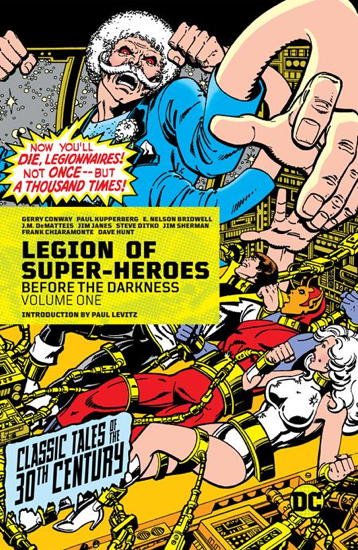
…continuing the complete reprinting of the Legion of Super-Heroes that began in the Legion Archives hardcovers and living on in these differently formatted, cheaper to produce hardcovers which picked up where the Archives left off.
This volume brings us up to Legion of Super-Heroes #271, plus the Secrets of the Legion of Super-Heroes mini-series. That means we’re in the very early ’80s, and just about to the point where I started picking LSH off the stands. I was bit of a late starter, sort of, to the Legion, but I was instantly a fan and kept reading the book ’til about the New 52 era, which was just one reboot too many for the comic that had pretty much become known for its incessant reboots and the hope the New, Improved Legion would get traction this time.
Anyway, I like these books, and I suspect I’ll likely continue picking them up even as they start to overlap with the Legion comics I do have. You know, just to get the Great Darkness Saga on paper that isn’t terrible. I may stop once they hit that initial “direct sales only” series, which already exists on nice paper!
Did want to note that Paul Levitz, one time DC president/publisher and writer of the Legion, provides the introduction. He says that the contents within may feel a little…disjointed, due to various creative team pressures and deadline issues and stuff, but honestly when has a Legion story not felt somewhat like some of the pipes are rattling a bit? But Levitz does make some space to say some nice stuff about longtime DC editor/writer E. Nelson Bridwell, a fella that, from some things I’ve heard, may not have been afforded much respect from other folks in the field. Well, Mr. Bridwell’s writing, whether for a comic story or his explanatory editorial pages, were eagerly enjoyed by a young me, so he’s got my respect for certain.
Also wanted to note the artists in this volume…Joe Staton (always great), Jimmy Janes and Jim Sherman (both wonderful draftsmen…Sherman’s got a great splash with Light Lass that’s a knockout), and, of course, Steve Ditko. I’ve read that Ditko story before (hence the link to the previous post) and it’s pretty well out there.
You know, for someone who’s been having a hard time reading, I sure wrote a lot for other people to read. There’s some form of base irony there somewhere. But thank you for putting up with my typing, and we’ll chat again shortly.
Fellow oldie John Lancaster creaks
“I’ve always kind of liked the brief go-between of the Atomic Age (1948-1955). I know it isn’t widely used or recognized but a lot of the comics of that era just don’t ‘feel’ like Golden Age books, and they’re not quite Silver Age yet either.”
I almost brought up the “Atomic Age” label in that post, but in a very rare instance of me actually editing something out of my writing, I decided not to bring it up. But I suppose I should have, given its informal use for…geez, I can’t even remember the first time I saw it. It must have been in the ’80s sometime, and if I still had access to my former boss Ralph’s archives of old Overstreet guides I’d start a few decades back and spot-check my way forward, seeing if it turned up in the ads or the glossaries.
There have been attempts at trying to name these “grey” areas in comics history before…I seem to recall “pre-Golden Age” being used here and there, for example. I know Overstreet has “Victorian” and “Platinum” ages for anything older than, say, the 1920s I guess, but I don’t know if there’s enough trade in that material to make its usage commonplace, at least in our particular neck of the hobby. (I’ve had a grand total of one person in probably the entire 3+ decades I’ve been at this nonsense bring in a copy of a “Platinum” age comic, and she wasn’t willing to sell it for anywhere close to what the Guide suggested.)
(And an aside: consider that one instance of a Platinum Age comic to the literally HUNDREDS of times I wished Overstreet had any kind of comprehensive Undergrounds section.)
Anyway, back to “Atomic Age” – look, I know this is me taking that particular appellation at face value, but I always associated the term with the atomic-bomb covers that were prevalent during that period. I’d have a hard time calling a random issue of, say, Betty and Veronica an “Atomic Age” comic, as such, though I honestly wouldn’t put it past Archie Comics to have actually had a mushroom cloud on one of their comics during this period.
But I think at this point, splitting the hairs more finely than “Golden” and “Silver” for the comics of that time will likely not get more “officially” codified beyond the terms already in place. As cool as it sounds, and it does sound cool, I think “Atomic Age” will remain mostly informal. Unless Overstreet decides otherwise, of course.
John continues:
“It does feel like we’ve got to insert some kind of identifier for a chunk after ‘copper.’ We’re coming up on 30 years in the ‘Modern Age’ – almost the entirety of the Gold and Silver age combined. I certainly don’t know what that should be called, but whatever it is I’m sure I’ll hate it and refuse to use it until 20 years after it becomes popular.”
Well, Copper Age (a term John doesn’t much care for, and doesn’t exactly levitate my Lusitania either) I can at least see the reasoning behind, with the effective ending of what began in the Silver Age with the advent of Crisis on Infinite Earths in ’85, and taking us to the paradigm shift (if in ownership, not so much in content) of Image Comics. I’ve said…well, somewhere, maybe here or on Twitter, that “Image Age” may be a good name for the new emphasis on creator-owned books and competing superhero universes and of course the full-on flop sweat the industry gave off as they desperately tried to pull out of the ’90s crash. In fact, “Crash Age” may be a good name for that period…a period in many ways we sort of find ourselves in today.
And I’ve suggested “Rebirth Age” for the most recent period of comics and its focus on relaunching/rebooting everything at the drop of a hat or the change of a creative team in pursuit of a temporary bump upward in sales numbers. And we can even tie it to a Flash thing by having it begin with this Flash series, relaunched as a new ongoing before being quickly canned and reverting back to the previous numbering, sticking retailers with piles of stock ordered under the assumption it’d be around for a while feeding back issue sales. You may notice retailers not exactly ordering any new series with much confidence since then.
…Okay, kinda ran out my clock with all this typing. Will pick up again shortly.
My blogging time is going to be somewhat curtailed over the next couple of days, so don’t expect to the typical Progressive Ruin Wall O’Text™ at least ’til Friday, thanks to some too-early morning appointments over the next couple of days.
So let me answer Wayne’s question very briefly here, where he asks if anyone’s seen the Palisades Park coupons you used to see in Silver Age DCs ever clipped out.
I actually wondered about this myself about a year and a half ago on the Twitters, on the slightly broader topic of finding clipped coupons in comics:
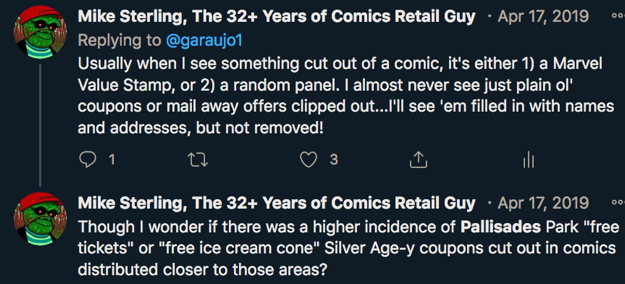
And as you see there, the answer is “nope,” presuming that most of the comics I’ve come across were not from the general area of said park, thus presenting a reduced incidence of clipped coupons. Or kids didn’t want to cut up their comics, which is also possible given the number of surprisingly not-cut-up comics I’ve encountered in collections over the decades. Not saying there were none, but not nearly as many as you’d think, especially with the puzzles and dioramas and whatnot you’d see in Dell Comics, which practically begged kids to ask their parents for permission to use the scissors.
Okay, the primary exception to this is Incredible Hulk #181, which, like, 90% of the time is missing the Marvel Value Stamp. DARN YOU SHANNA THE SHE-DEVIL FANS! …Actually, my theory as to why we see H181 missing the stamp so often where other comics with stamps usually still retain them is because H181 still has significant value and remains sought after even without the stamp. Most other Marvel books with the stamp cut out get tossed in the dollar box or just tossed out…okay, maybe not “tossed out” but boy they don’t go for much, usually.
Anyway, off track, and I want this short. Any of you notice Palisades Park coupons missing from your books? Just curious if anyone’s noticed this.
So Matthew asked last week sometime
“Speaking of the ‘copper age,’ What years and terms do you use to define different eras of comics?”
Which, you know, fair enough, since I’m very vocally not a huge fan of that very term “copper age,” which still to my ear smacks very much of a marketing term generated to make back issues of Nomad sound rare and collectible.
I’ve gone into detail on this before, actually also in response to a query from the very selfsame Matthew, in this post from last year. Actually, I’m glad for the chance to revisit that post becuase just the briefest of glances revealed some pretty awful typos (which I’ve since fixed), and more to be found, I’m sure. I’m guessing this was written during one of my “cloudy vision” periods, of which there have been too many. But I presume most of you got the gist of my typical too-long foray into the nomenclature of comic ages then, despite my obfuscated spelling and word use.
But to defy tradition and provide a more succinct answer to this most recent query, let me say to you, Matthew, that I use “Golden” and “Silver” frequently, and “Bronze” less so. However, as we get farther away from the period supposedly defined by “Bronze,” i.e. circa 1970 through 1984, I find my incidences of usage increasing, perhaps identifying a psychological barrier against acceptance. “Why, there can’t be an ancient sounding ‘age’ for that period…that’s my time frame!”
A naming of ages is, almost by definition, a matter of historical definition, and one tends not to think of a time lived through as being “historical,” no matter how long ago, in truth, that time may be. However, I suppose, 35 to 50 years on, I must bite that bullet and accept that the range of years is thusly dubbed.
As has been pointed out by some, including me in that very post from last year I linked above, some distance is needed to fully appreciate the characteristics of the industry’s behavior before one can really begin to divvy up specific eras into “ages.” I go into a little detail at the end of that post about what I think the current “age” might be called [attention Allen M, who brought this up last week], but we’re still way, way too close. So long as it isn’t “the Final Age,” a joke I’ve made at some point in the past here or on Twitter, though truth be told I’m only about half-joking.
Okay, I clearly didn’t defy any ProgRuin traditions with that answer, so let me move on to another response to last week’s post.
• • •
Tenzil Kem, Esq., bites off more than I can chew with
“I get the argument about the ‘rarity’ of newsstand comics vs. direct market, although I’m not sure if newsstand copies from the 70’s/80’s are truly that much rarer (since, as you know, print runs were hundreds of thousands of copies and available widely back then). I think the argument is stronger for comics from this century, such as DC New 52 newsstand issues with the higher cover prices, but I still don’t know that it should translate into higher valuations.”
Oh, sure, I’m not sure I was clear on that, but yeah, with comics from when newsstand distribution was still a major thing, there really shouldn’t be much of a difference, if any, in secondary market pricing. It should be restricted to more modern releases, though, as I noted in that post, I’m not a fan of that sort of pricing behavior anyway. I understand the impulse, but it still feels like making a collector’s item out of nothing for no really solid reason. (Like, as you say, the price differences on those DCs, but even then that’s bit of a stretch).
Now look, when it comes to collector’s markets, it’s the money that talks, not me, and history will side with whatever makes some people’s wallets fatter while I walk the streets with my sandwich board filled with tiny scrawled handwriting. I’m sure eventually I’ll fall into line if the back issue market leans in that direction, but rest assured I’ll be making passive-aggressive complaints about it on whatever Nazi-free microblogging platform eventually replaces Twitter.
“For that matter, I don’t like the inflated back issue pricing on comics with Mark’s Jewelers ads, and I have several of those that my grandparents bought me from the Fort McClellan PX near Anniston, AL.”
Yeah, that’s been a thing for years, but I think tradition has won over any objections we might have had. To be fair, if a comic came with some kind of insert, and that insert is removed, then that comic is not “as new” and should be graded accordingly. While I think advertisements should be treated differently from inserts more directly related to the comic book, or comics in general (like, say, trading card inserts that Marvel would occasionally include in their books throughout the ’90s), the problem of “where is the line drawn” does begin to creep in.
The imperfect analogy that immediately comes to mind is the usual comic grading policy of “age is not an issue.” A comic from the 1940s is held to the same grading standards as a comic that came out last Wednesday (or Tuesday, if it’s a DC). Otherwise you have to create sliding scales for what is considered “mint” or whatever for multiple time periods, and frankly, that sounds like an enormous pain the All-Star Squadron. With that as precedent, one can perhaps see where trying to distinguish between the kinds of inserts would eventually turn problematic, and it’s simply easier to apply the same pricing/grading rules to any comic with any insert.
As a side note, you’d think having the stiff-paper trading card inserts or jeweler ads would create a wider prevalence of these comics being in higher conditions with less spine creasing. Let me tell you, friends, that this is not the case.
“I’ll go full grumpy old man and complain about Canadian price variants and British price variants because I feel those are just “rare” here in the USA.”
An issue I recently experienced when I acquired a large number of 1960s Marvels and DCs from a lady who’d spent her youth in England. The DCs were all stamped with ink impressions featuring the price in, I don’t know, ha’pennies or whatever was goin’ on there, but were otherwise as distributed in the U.S. with the American prices printed thereon.
The Marvels, however, were printed with British pricing replacing the U.S. pricing on their covers (for the most part…there were one or two that also had to be stamped). I wasn’t quite sure what to do with these in regards to back issue pricing…especially as some of them were quite the in-demand books (such as the first appearance of Black Panther).
Did a little research, consulted with former boss Ralph, and eventually decided to just price ’em up as normal. I mean, these weren’t new, different foreign editions produced specifically for their markets. It’s the exact same contents, exact same covers and ads, the only difference is that the U.S. price was swapped out with another price at some point during the printing process. This minor cosmetic change might increase demand as “a variant,” might decrease demand as “a repint” (which I don’t think it is), so I just split the difference.
“With all of these examples, I think sellers are just trying to justify why someone should pay more for their specific copy, but the market seems to be looking for rarity wherever it can find it.”
As I’d noted…or rather, as a customer brought to my attention and I shared here, as older comics become less available folks are looking for reasons to make newer, more common comics into collector’s items. Even with brand new comics, as almost any “first appearance” that turns up in a recent release inspires the purchase of multiple copies, even when more often than not any increased value that accrues is more of a self-fulfilling prophecy than any indication of organic widespread demand. Investors create the scarcity that increase the demand from those who need the issue and couldn’t get it because investors bought them all. Artificial rarity…those who forget the ’80s are doomed to repeat them.
So I had one of my longtime customers ask me the other day what my thoughts were on the collector focus and increased pricing on newstand editions of certain comics versus those that were sold through comic shops. By and large, the only difference between the two are the UPC codes, where the one that went through traditional outlets like newsstands, convenience stores and the like would have ’em, and comics sold in the direct market either didn’t have UPC codes or had the UPC marked “Direct Sales” to differentiate from the other.
Now, my personal feeling is that pricing on the two variations of a comic, newsstand or comic shop, should be the same so long as the only difference between the two is the UPC code. If there are other variants, like different cover images (like Amazing Spider-Man Annual #21) or other changes in details about the comic (like the “9 cent” Fantastic Four having the regular cover price for newsstands), then maybe, sure, there may be some variations in pricing.
I did briefly posit that this newsstand/direct disparity in back issue pricing felt like it was a trend of forcing something into collectibility, but the customer noted something about that I hadn’t considered. That said forcing of collectibility was coming about because actual older collectible comics are in much shorter supply than they used to be. Golden Age, and even a lot of Silver (particularly Marvel) don’t just drop out of the sky every day like they used to. Maybe, he theorized, collectors are trying to make some silk purses out of their boxes full of sow’s ears by claiming some of the comics they do have access to now have some extra value accrued to them.
Now technically, I suppose newsstand editions are “variants,” particularly in latter days when newsstand distribution of comics dropped and new comics were primarily available through comic book stores. As my customer suggested, in earlier years, newsstand distribution was, of course, much higher, but as soon as UPC codes started being affixed to periodicals in the late-ish 1970s, we were at the beginning of the end for that form of distribution as comic shops took over.
As a result, newsstand editions were in less supply (and also more likely to end up in the hands of non-collectors, who were apt to destroy or damage the comic beyond collectibility, effectively removing it from the secondary market ecosystem). Even in cases like Alf, which apparently sold extremely well on newsstands versus its fairly moribund movement in comic stores, seems in short supply for these reasons. I mean, I’m just making some assumptions here, based on my observation of local market conditions…for all I know the state of Vermont is flush in Alf comics, the streets of Burlington just swimming with copies of the Alf Holiday Special.
I’ve seen this sort of forced collectibility before…in fact, I see it a lot now, as I get phone calls and walk-ins requesting copies of whatever the Hot Book of the Week is, usually featuring the first appearance of whomever, which is already listed for get-rich-quick prices on eBay. Remember when folks were all frantic about the first appearance of the Gold Lantern in Legion of Super-Heroes? …Yeah, I know, “who?” Anything that even feels like a first appearance of somebody is an investment potential…but not every first appearance, so don’t bother trying to order lots of copies ahead of time, because you won’t know for sure you’ll need them ’til the day of release which is when everyone will start asking.
And it all depends on “supply,” too. I could order extra numbers of all the later appearances of Gold Lantern…but so could everyone else, and now that it’s readily available, no one’s interested. Or that recent “X of Swords” event for Marvel…early issues were in high demand, because orders on it were generally low. That same demand hasn’t turned up for newer installments, ordered in numbers based on all the folks clamoring to for first installments, a lot of whom didn’t come back for the rest. Even restocks of those “hot” first installments have barely moved, now that anyone can get them.
I’m getting a little off track here, ranting about things I’ve already ranted about, as per usual. Back to the increased pricing on newsstand books…look, I can see why, particularly in cases where newsstand sales were less than the same book’s direct market circulation. It’s just after years where the conventional wisdom was that the two versions were priced the same, and now they’re not. As an old person, I hate change, but I suppose I need to get used to this new paradigm sooner rather than later.
Hey, I eventually got used to using “Bronze Age” (once described in Overstreet’s glossary as “widely unaccepted”). I use it fairly freely now…but I’m still drawing the line at Copper Age. I mean, c’mon, honestly.
As noted by the folks in the comments to my wishing for reprints of Jughead’s Folly and Jughead’s Fantasy…lo, they were indeed reprinted. Folly was reprinted, apparently in its entirety (as there were more stories than the “Jughead becomes a rock star” lead) in the Best of Archie Comics #3 digest/book from 2013, and again in the Archie 75th Anniversary digest from 2017. Likewise, the three issues ofJughead’s Fantasy have been reprinted multiple times from the 1960s into the 2010s (and I’ll let you look at the individual entries for that info).
So my hasty supposition that Jughead’s Folly not being reprinted, and my inference that Fantasy also had not, was completely incorrect. Look, not everyone has the time to put in the whole 10 seconds of research it would have taken me to find this info out in the first place.
I suppose I could probably seek these reissued forms of the original stories…comic book sized preferred, as my aged and long-distressed eyes are no longer up to the challenge of digest-sized comics. I realize there’s no real difference in reading the story in a more recent comic versus reading it in its original release, but I just plain like the look of Archie covers from that period. I’m gonna be one of those guys who’s got to have the originals for their look ‘n’ feel.
A second choice would be “facsimile editions,” like what Marvel and DC have been doing of late. Just more or less exact reprints of the original comics, except on better paper and a higher price. I’ve picked up a handful of those over the last couple of years…they’re fun to have, and that way I can get a copy of the comic without taking something out of the shop I might actually be able to sell for money.
Third choice would be a some kind of handsome hardcover or softcover, which would hopefully include full-color and full-sized reproductions of the covers (and not just little thumbnails on the back cover).
I suppose a fourth choice would be digital editions, but frankly I’d rather have a physical edition. Even if, er, a digital version would be slightly easier for me to read now.
I don’t know…maybe I’ll get luckly and someone will bring all these Jughead comics into the shop for me to buy. I figure if my store is open long enough, every comic I want will eventually pass through! That’s my fantasy…or, more likely, my folly.
So here’s a weird thing a customer brought in for me to deal with. It’s a copy of Voyage to the Bottom of the Sea #1 from 1964:
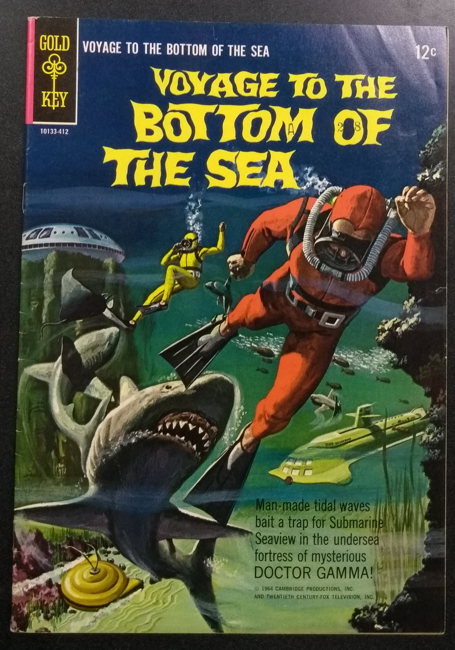
…which was at one point apparently processed by the Library of Congress:
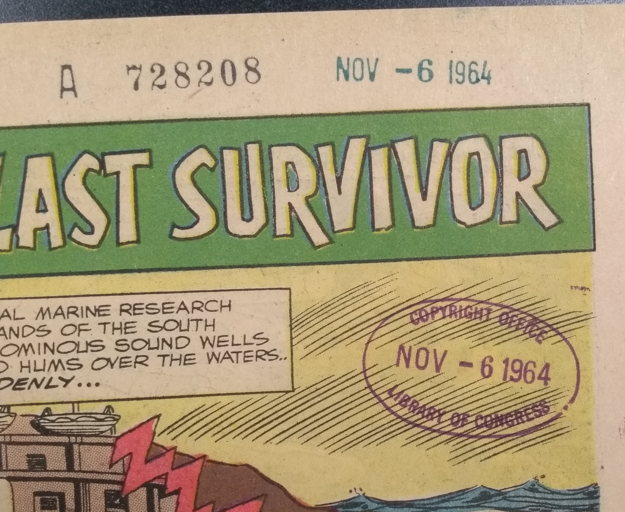
The customer said that the seller he bought it from had mentioned that apparently that the Library of Congress had ended up with an extra copy of this comic in the system and unloaded it, which seemed a little odd to me but apparently the ol’ LoC does stuff like that.
When I posted about this on the Twitters, pal Nat responded that it may not have ever been in the Library’s archives, but just a copy submitted for copyright reasons and stamped during the process.
I mean, Nat’s probably right, he knows from publishing, after all, and my own knowledge of how the government actually operates is pretty lousy, leaving me suitable just for selling comics or being a Supreme Court nominee, so I defer to his wisdom. Regardless, this seems fairly unusual, as I’ve not seen something like this in the too many years I’ve been on the job. Or, who knows, maybe they’re common as dirt around, oh, say, Washington, D.C. “Ah, geez, another one,” says the manager of Lincoln Memorial Comics and Games, as he tosses his third LoC-stamped copy of H.A.R.D. Corps #1 in to the recycle bin.
I’m not entirely sure what to do with it…the customer is okay with me selling it on consignment, though I’m not sure what to charge. It’s not a bad copy, aside from that crumpled corner. so probably somewhere between Very Good and “Qualified Near Mint,” I reckon.
In other back issue news, I was going through some of the many boxes of comics that have been piled upon me by folks over the last few years of my store’s operation, pulling out things I can use right now. And one of those things was a 1991 issue of Silver Surfer, autographed in that very same year by the book’s artist, Ron Lim:
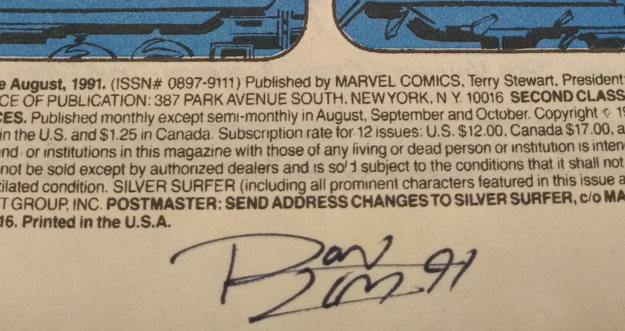
Well, that’s kind of a neat surprise! Alas, the comic itself is not in the greatest of shape, so any premium I was thinking of putting on the book (which wasn’t going to be an outrageous mark-up at any rate) was rendered mostly moot. But still…kind of a neat thing to be surprised by!
So let me issue a correction, as my dad took great glee in calling me at the shop Monday afternoon to cheerfully let me know I was filthy, filthy liar for claiming, as I did in the subject line to that day’s post, that I had never been in a Piggly Wiggly grocery store.
As it turns out, I had been in a Piggly Wiggly, in an Alabama location in early 1976 as we made our way cross-country in a U-Haul truck, making our move from Centreville, VA to Port Hueneme, CA. It was there, my dad informed me, that I obtained a ball (or “egg”) of Silly Putty. And I do remember that Silly Putty quite well, , stretching it, shaping it, bouncing it around, and using it to pull pictures off of comic books…specifically, this issue of Weird Wonder Tales #15:
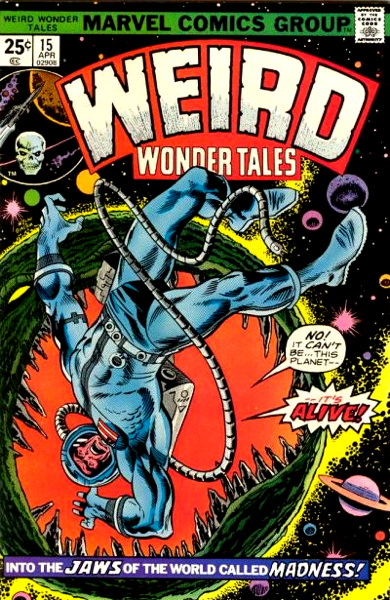
…and mainly from the story “The Man Who Owned The World!” by Denny O’Neil and Tom Sutton, with which I was particularly fascinated.
In addition to all that fun I was having, my dad also informed me that I got Silly Putty all over my clothes, all over his and Mom’s clothes, in the cabin of the U-Haul truck, around the various hotel rooms, on Alabama’s state bird the northern flicker (AKA the yellowhammer), possibly on the Alabama Crimson Tide’s defensive tackle Bob Baumhower, and who knows what and/or who else. So a big thanks to Piggly Wiggly for providing us all that entertainment 44 years ago!
• • •
Going to recommend a podcast episode here, from Twitter pals
Sean42AZ and
garaujo1: it’s
the latest episode of “The Never Ending Reading Pile,” in which they discuss
Alpha Flight, with a special focus on issue #29, the One Right About When The Creative Teams of
Alpha Flight and
Incredible Hulk Swap Books. It’s long, yes, but engrossing, and the two fellas dive deep into the series as a whole and discuss just what was going on behind the scenes to enable this creative team switcheroo. I don’t listen to many comic podcasts, but this one is certainly worth your time.
• • •
Will look at more of
your questions next time. Thanks for reading, pals.
« Older Entries
Newer Entries »


 THUS, THE CULLING BEGAN. I started going through the stuff I did pull for myself and deciding just what I can pass up for now. The big loser here, unfortunately, was Marvel’s many Star Wars titles. Not to say I didn’t enjoy them…I did, they were a lot of fun, but it’s just too much and with Marvel’s crazy publishing schedules, it just stacks up too quickly.
THUS, THE CULLING BEGAN. I started going through the stuff I did pull for myself and deciding just what I can pass up for now. The big loser here, unfortunately, was Marvel’s many Star Wars titles. Not to say I didn’t enjoy them…I did, they were a lot of fun, but it’s just too much and with Marvel’s crazy publishing schedules, it just stacks up too quickly. 











